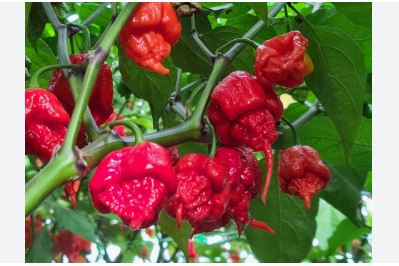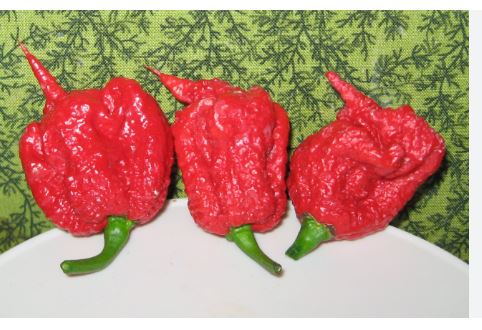
The Carolina Reaper is classified under the genus Capsicum and the species Capsicum chinense, a group known for producing some of the hottest peppers, including habaneros, Scotch Bonnets, and Trinidad Moruga Scorpions. The Capsicum genus, part of the Solanaceae (nightshade) family, includes over 30 species, but C. chinense is distinguished by its wrinkled, pungent fruits and high capsaicin content. The Carolina Reaper is a hybrid, created through selective crossbreeding of a Pakistani Naga (likely a Bhut Jolokia variant) and a red habanero from St. Vincent. This hybridization enhances its capsaicinoid concentration, particularly in the placenta and locules, making it one of the most potent chilies. Its botanical profile aligns with C. chinense traits, such as slow germination, tropical climate preference, and bushy growth.
The Carolina Reaper was bred by Ed Currie, a chili enthusiast and founder of PuckerButt Pepper Company, in Rock Hill, South Carolina. Currie began developing the pepper in the early 2000s, aiming to create a chili that combined extreme heat with robust flavor. After years of crossbreeding and stabilization, the cultivar, initially called “HP22B” (Higher Power, pot 22, plant B), was tested in 2012 at Winthrop University, where it averaged 1.57 million SHU. In 2013, Guinness World Records declared it the world’s hottest pepper, a title it held until Pepper X’s certification in 2023. The Reaper’s origins lie in the genetic heritage of C. chinense peppers, which trace back to the Amazon basin, but its modern form is a product of American innovation and meticulous breeding.
The Carolina Reaper’s heat is legendary, averaging 1.57 million SHU, with individual peppers reaching up to 2.2 million SHU, as verified by HPLC testing at Winthrop University. For comparison, it is 880 times hotter than a jalapeño (2,500 SHU) and significantly hotter than a habanero (100,000–350,000 SHU). Its capsaicinoids, concentrated in the placenta and inner membranes, deliver a prolonged, searing burn that can cause intense discomfort, including mouth and throat burning, sweating, nausea, and even temporary breathing difficulties. The heat builds gradually, peaking after 10–20 seconds and lingering for up to an hour, making it a favorite for extreme chili challenges but a challenge for casual consumption. Handling requires gloves and eye protection to avoid capsaicin burns.

Beyond its ferocious heat, the Carolina Reaper offers a surprisingly complex flavor profile, a testament to Ed Currie’s focus on taste as well as pungency. The initial taste is sweet and fruity, with notes of citrus, tropical fruit, and a hint of cinnamon or chocolate, typical of C. chinense peppers. This fleeting sweetness is quickly overtaken by an intense, fiery heat. The Reaper’s appearance is distinctive, with small, wrinkled, gnarled pods (1–2 inches long) that ripen from green to bright red, often featuring a scorpion-like tail and bumpy, pockmarked skin. Its compact plants, growing 3–5 feet tall, are bushy and productive, yielding dozens of pods under optimal conditions. The pepper’s high capsaicin content also gives it a slightly oily texture, enhancing its potency.
The Carolina Reaper’s extreme heat limits its use in everyday cooking, but it has carved a niche in specialty culinary applications and beyond. It is a star ingredient in ultra-hot sauces, such as PuckerButt’s Reaper Squeezin’s and The Last Dab series on Hot Ones, where it adds intense heat and fruity notes to wings, tacos, and burgers. In small doses, it enhances salsas, chili powders, and spice blends, often diluted with milder ingredients to balance its potency. The Reaper is also used in competitive eating challenges and chili festivals, where daring participants test their tolerance. Outside the kitchen, its capsaicin is explored for medicinal purposes, including pain relief creams and potential anti-inflammatory treatments, though such uses require careful processing. Home cooks should use it sparingly, ideally with dairy (milk, yogurt) to counteract the burn, and always handle with gloves.
The Carolina Reaper’s global popularity has made it widely available, unlike the proprietary Pepper X. Seeds, plants, and fresh or dried pods are sold by numerous vendors, and its cultivation has spread to home gardens worldwide. Its intense heat has sparked a subculture of chili enthusiasts who grow, trade, and compete with Reaper-based products. However, its potency comes with risks: overconsumption can lead to severe digestive distress or, in rare cases, medical emergencies like thunderclap headaches. The Reaper’s cultural impact extends to social media, where videos of people attempting to eat it raw garner millions of views, cementing its status as a symbol of extreme spice.

Cultivation of Carolina Reaper
1. Climate and Temperature
Carolina Reaper thrives in hot, humid climates, mirroring the tropical origins of Capsicum chinense. Optimal daytime temperatures range from 70–85°F (21–29°C), with nighttime lows above 60°F (15°C). Temperatures below 54°F (12°C) can stunt growth, while prolonged heat above 95°F (35°C) may reduce fruit set. In cooler regions, use greenhouses, high tunnels, or indoor setups with grow lights to extend the 90–120-day growing season required for mature, pungent pods. Consistent warmth is critical to maximize capsaicin production.
2. Soil Requirements
Grow Carolina Reaper in well-drained, loamy soil with a pH of 5.5–6.5, slightly acidic to optimize nutrient availability. Incorporate organic matter like compost or aged manure to improve fertility and water retention. Avoid heavy clay soils, as C. chinense has shallow roots prone to rot in waterlogged conditions. Conduct a soil test to ensure balanced levels of phosphorus and potassium, as excessive nitrogen can promote leafy growth over fruit development, reducing heat intensity.
3. Seed Starting
Start Carolina Reaper seeds indoors 8–12 weeks before the last frost, as C. chinense seeds germinate slowly (14–28 days). Use a sterile seed-starting mix and maintain soil temperatures of 80–90°F (27–32°C) with a heat mat for best results. Provide 16 hours of bright light daily using LED or fluorescent grow lights to prevent leggy seedlings. Keep the soil consistently moist but not soggy, and use a humidity dome to retain moisture during germination. Seeds are widely available from reputable vendors.
4. Transplanting
Transplant seedlings outdoors or into a greenhouse when soil temperatures reach at least 65°F (18°C) and nighttime lows stay above 60°F (15°C). Space plants 18–24 inches apart in rows 24–36 inches apart to accommodate their bushy, 3–5-foot-tall growth. Choose a site with full sun (6–8 hours daily), as sunlight enhances capsaicin production. Harden off seedlings over 7–10 days to acclimate them to outdoor conditions, minimizing transplant shock.
5. Watering
Provide consistent, deep watering to keep soil moist but not waterlogged, as Carolina Reaper is sensitive to both drought and overwatering. Water 1–2 times weekly, delivering 1–2 inches of water, adjusted for soil type and climate. Sandy soils may need more frequent watering. Use drip irrigation or soaker hoses to keep foliage dry, reducing fungal disease risk. Inconsistent moisture can cause blossom-end rot or cracked fruits, so monitor soil moisture, especially during flowering and fruiting.
6. Fertilization
Apply a balanced fertilizer (e.g., 10-10-10) at planting to establish strong roots, then switch to a low-nitrogen, high-potassium formula (e.g., 5-10-15) during flowering and fruiting to boost fruit production and capsaicin levels. Fertilize every 2–3 weeks, following soil test guidance to avoid over-feeding, which can dilute heat. Organic options like fish emulsion, seaweed extract, or compost tea are effective alternatives. Avoid excessive nitrogen, as it can lead to lush foliage at the expense of pods.
7. Mulching
Apply a 2–4-inch layer of organic mulch, such as straw, wood chips, or grass clippings (herbicide-free), to conserve moisture, suppress weeds, and regulate soil temperature. Black plastic mulch is highly effective for warming soil, especially in cooler climates, and can increase yields by maintaining root zone heat, critical for C. chinense. Mulching also prevents soil splash onto leaves, reducing the risk of soil-borne diseases like bacterial leaf spot.
8. Plant Density
Optimize plant density to balance yield and pungency, as studies on C. chinense suggest spacing impacts fruit production. A density of 15,000–18,000 plants per hectare (6,000–7,300 per acre) can maximize fruit number and capsaicin content per area, while lower densities (10,000–12,000 per hectare) may increase individual plant yields. For home gardens, stick to 18–24-inch spacing to ensure adequate airflow and light, preventing disease and supporting robust fruit set.
9. Pest and Disease Management
Carolina Reaper is vulnerable to pests like aphids, spider mites, and whiteflies, and diseases such as bacterial leaf spot, anthracnose, and viral infections (e.g., Tobacco Mosaic Virus). Use integrated pest management (IPM) with neem oil, insecticidal soap, or beneficial insects like ladybugs. Monitor for leaf curl or mosaic patterns, indicating viral issues, and remove affected plants. Ensure good air circulation, avoid overhead watering, and rotate crops every 2–3 years to minimize soil-borne pathogens.
10. Pollination
Carolina Reaper is self-pollinating, with small, white, five-petaled flowers that set fruit without external pollinators. However, gentle shaking of plants or introducing bees can improve fruit set, especially in greenhouses or areas with low pollinator activity. High temperatures (above 90°F/32°C) can reduce pollen viability, so provide shade cloth or misting during heatwaves. Each node typically produces 2–4 fruits, and consistent pollination ensures the characteristic wrinkled, tailed pods.
11. Pruning and Support
Lightly prune Carolina Reaper plants to remove suckers, dead leaves, or lower foliage touching the soil, improving airflow and reducing disease risk. Avoid heavy pruning, as it can stress C. chinense and lower yields. Use stakes, cages, or trellises to support bushy plants, especially during fruiting, as heavy pod loads can snap branches. Support is essential for the Reaper’s prolific yields, which can produce dozens of pods per plant.
12. Harvesting
Harvest Carolina Reaper pods when they ripen from green to bright red, typically 90–120 days after transplanting, for maximum heat and flavor. Some pods may develop a scorpion-like tail or bumpy, wrinkled skin, signaling maturity. Use gloves and scissors to cut pods, avoiding skin contact with capsaicin-rich tissues, which can cause burns. Regular harvesting encourages further fruit production. Pods can be used fresh, dried, or powdered, but handle with care due to their extreme potency.
13. Challenges and Considerations
Cultivating Carolina Reaper is challenging due to its long growing season, sensitivity to temperature extremes, and susceptibility to pests and diseases. Its extreme heat (up to 2.2 million SHU) requires protective gear during handling, as capsaicin can irritate skin, eyes, and respiratory systems. Inconsistent watering or nutrient imbalances can reduce capsaicinoid content, diluting the pepper’s signature heat. Growers in cooler climates may need season-extension tools like row covers or heated greenhouses. Despite these hurdles, the Reaper’s availability as seeds and plants makes it accessible, and its cultivation rewards dedication with high yields and unparalleled pungency.